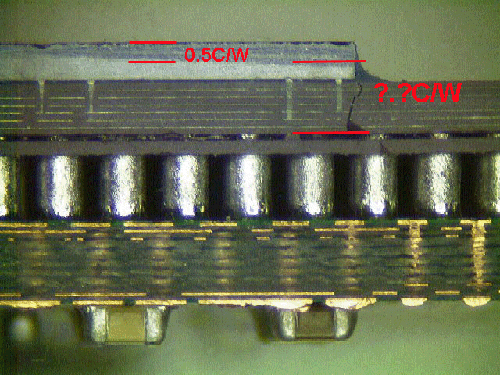|
|
|
VII. Temperature Compression further explained
This section will further explore the temperature compression problem in more detail.
The first bit of information comes from AMD. They state that Ccore(Core temp) to Ctop(CPU backside) resistance is .5. Who knows what Ccore to Cback(of ceramic PCB) is? AMD certainly does not let us know.

This is a CPU cutaway shot, from http://www.valley.ne.jp/~nhideo/e_ath750.htm . The core sits completely on top of the Ceramic PCB. You get some 7-odd layers of ceramic PCB(almost certainly designed to NOT radiate heat). While this is a slot A t-bird, the section above the "tin or silver pegs" is most certainly the same as a socket CPU.
You get an absolute minimum of .5 thermal resistance to back, in addition to whatever thermal resistance the 7 layers of ceramic add to it. This leads to the tremendously compresed temperature readings when using socket-thermsitors.
Knowing that certain heatsink "readings" have a temperature compression of 5 to 1 or 6to 1, you're looking at major compression factors. Abit and Asus recognized the problem, and have added a "compensation" to their socket-thermistor temps, but these "compensations" have very limited ranges where they are "effective"(namely 1ghz or roughly 50-55W cpu's cooled with .4C/W heatsinks, roughly).
Is there a fix to the compression problem? Is there an internal diode on the
athlon? If I had to guess, I would say yes. I'm pretty sure that when AMD is
binning their CPu's that they would want accurate, relative, and Internal
Core temps. Whether the pins are accessible are an entirely other question.
This leads to another problem. People are experiencing CPU failures despite CPU "temps of 35-40C". One problem with not giving accurate readings is people don't generally have an indication that something is wrong. And if you go to the next page, where I p3-internal diode temps are compared to socket-thermistor(same setup) temps, certain heatsinks can give misleading socket-thermsitor temps.
I understand the marketing aspect behind not either implementing an internal diode or allowing access to it. AMD does not want consumers to see their CPU's running 10-15C higher than Intel Chips(I have no problem with AMD running warmer, their CPU's are certainly capable of it). Given a choice of having inaccurate readings, versus accurate, relative results, i would choose the later.
Problem VIII: Diode Versus Thermistor P3 Testing, Continued